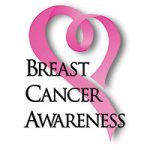October is breast cancer awareness month

 Amid the fall colors — the beautiful yellows, reds and oranges of the trees — you may have noticed a sea of pink: pink scarves, pink socks, pink shirts and pink coffee mugs.
Amid the fall colors — the beautiful yellows, reds and oranges of the trees — you may have noticed a sea of pink: pink scarves, pink socks, pink shirts and pink coffee mugs.
It’s October, and pink is the color of the month.
October is Breast Cancer Awareness Month, an annual international health campaign organized by major breast cancer charities every October to increase awareness of the disease and to raise funds for research into its cause, prevention, diagnosis, treatment and cure. The campaign also offers information and support to those affected by breast cancer.
 Breast Cancer is the most common cancer diagnosed in women in the United States, other than skin cancer. It is the second leading cause of cancer death in women, after lung cancer.
Breast Cancer is the most common cancer diagnosed in women in the United States, other than skin cancer. It is the second leading cause of cancer death in women, after lung cancer.
The chance of a woman having invasive breast cancer sometime during her life is about one in eight. The chance of dying from breast cancer is about one in 37. Breast cancer death rates have been going down. This is probably the result of finding the cancer earlier and better treatment. Right now there are more than 3.1 million breast cancer survivors in the United States.
SCREENING FOR CANCER
When breast cancer is found early, it can be easier to treat. If you are 40 or older, talk to your doctor about the screening plan that’s best for you and report any breast changes right away.
Most women who are 50 to 74 years old should have a screening mammogram every two years. If you are 40 to 49 years old, or think you may have a higher risk of breast cancer, ask your doctor when to have a screening mammogram.
There are some guidelines, though. Breast self-exams are to be done monthly, and the best time to do them is about 10 days after the onset of your menstrual cycle. Breasts can be capricious, and they will change texture over the course of the monthly cycle, so sticking to one time of the month is best. If you no longer menstruate, then choose a day of the month and do it that same day from then on.
The second guideline is to have your doctor examine your breasts. Find a doctor that you’re comfortable with, because he or she will be squeezing your breasts and looking at them rather closely every year. A lot of people would rather do it themselves, but if you were to find an abnormality, you’ll need your doctor’s help in getting the proper tests done to determine what is wrong. Only your doctor can provide a prescription for a breast sonogram or diagnostic mammogram.
 The last guideline is to get a mammogram. This only applies to certain people: women over 40 (or mid- to late-30s if breast cancer runs in the family because a woman’s risk of breast cancer approximately doubles if she has a first-degree relative who has had breast cancer), and patients with an abnormality in the breast.
The last guideline is to get a mammogram. This only applies to certain people: women over 40 (or mid- to late-30s if breast cancer runs in the family because a woman’s risk of breast cancer approximately doubles if she has a first-degree relative who has had breast cancer), and patients with an abnormality in the breast.
It is not generally recommended to get a mammogram before the age of 35. If a patient younger than 35 finds a lump, the first exam ordered will likely be a sonogram because it does not utilize radiation.
Doctors are so confident that they can treat stage-one breast cancer that they give patients a near 100-percent, five-year survival rate.
These three things are your best bet for catching breast cancer in its earliest stages. Trust your judgment when it comes to your body. If it doesn’t feel right, have it checked out. The worst (or best) thing that can happen is that you get checked and it turns out to be nothing.
For more information you can visit www.nationalbreastcancer.org/breast-cancer-awareness-month and www.cdc.gov/cancer/breast/



Leave a Reply